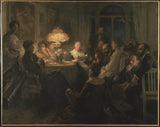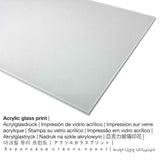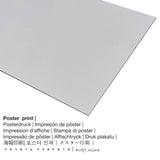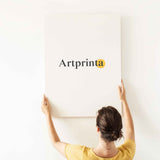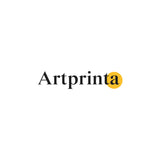Hanna Hirsch-Pauli, 1900 - Marafiki - uchapishaji mzuri wa sanaa
Kodi ni pamoja. Usafirishaji umehesabiwa katika Checkout.
Maelezo ya mchoro asili kutoka kwenye jumba la makumbusho (© - na Nationalmuseum Stockholm - Makumbusho ya Taifa ya Stockholm)
English: In the large drawing room, which is suffused with a warm light and a contemplative atmosphere, a group of people have gathered. Centre-stage, in the light of the evening lamp, sits Ellen Key, reading to her friends. In the twilight, they have all come to the home of the Pauli family at Bellmansgatan 6 in Södermalm, Stockholm. The painting can be seen as a monument to the meaning of friendship and at the same time as an element in the launch of a new cultural elite. Hanna Hirsch-Pauli sits as an observer in her own drawing room, pen and pad in hand, watching her friends. She has presented them as a close-knit circle, but with each person characterised individually. Initially it was some of the women who were socialising, but the group later expanded to include Hanna and Georg Pauli’s artist friends from their Royal Academy days and their time in Paris as well as others from the art colonies in Barbizon and Gréz-sur-Loing. The names of the Friends illustrate how closely the new cultural elite of the time was connected with the financial elite. In the late 1870s, Ellen Key had given private lessons to a group of upper middle class girls from Stockholm’s Jewish community. Three of them are depicted in Friends, at the table by Ellen Key, whom they saw as something of a mentor when it came to their intellectual, social and emotional development. Ellen Key was a philosopher and one of Sweden’s more controversial and well known cultural figures. Her thoughts on love, parenting, marriage and sexuality influenced generations around the turn of the 20th century. Ellen Key sought to break down the divide between private and public life. She felt that the home should be a model for the whole of society. She sought to politicise the home and family relations through books such as Beauty for All, 1899 and The Century of the Child, 1901. Caption: From left: the artist’s sister Betty Hirsch, actress Olga Björkegren, Lisen Bonnier, artist Nanna Sohlman Bendixson, Ellen Key, Hanna Hirsch-Pauli, Gerda Berg and the artist Richard Berg, publisher Karl Otto Bonnier, artist Georg Pauli, educationalist and writer Artur Bendixson and author Klas Fåhreus (plus unknown figure in the window.) I det stora vardagsrummet, som är fyllt av ett varmt ljus och en kontemplativ stämning, är en grupp människor samlade till högläsning. Centralt placerad i bilden, i aftonlampans sken, sitter Ellen Key och läser högt för sina vänner i Sällskapet Juntan. I skymningen har de alla samlats hemma hos familjen Pauli på Bellmansgatan 6 på Söder i Stockholm. Målningen skall ses både som ett monument över vänskapens betydelse och samtidigt som en del i lanserandet av en ny kulturelit. Som observatör i sitt eget vardagsrum sitter konstnären själv, Hanna Pauli, med penna och teckningsblock tillhands och iakttar sina vänner. Hon har framställt dem som en krets, en bild av förtätad gemenskap, men där varje individ är enskilt karakteriserad. Från början var det några av kvinnorna som umgicks med varandra men sedan utökades gruppen med Hanna och Georg Paulis konstnärskamrater från akademitiden och från Parisåren, andra från konstnärskolonierna i Barbizon och Gréz-sur-Loing. Namnen på Juntans medlemmar illustrerar hur nära tidens nya kulturelit var lierad med finanseliten. Ellen Key hade i slutet av 1870-talet gett privatundervisning åt en grupp högborgerliga flickor ur den judiska Stockholmskretsen. Tre av dem finns med i Vänner, i kretsen runt bordet kring Ellen Key och för dem framstod hon som något av en förlösare när det gällde deras intellektuella, sociala och emotionella utveckling. Ellen Key var filosof och en av Sveriges mer stridbara och berömda kulturpersonligheter. Hennes tankar om kärlek, barnuppfostran, äktenskap och sexualitet formade generationer kring sekelskiftet 1900. Ellen Key sökte överskrida gränsen mellan det privata och det offentliga livet. Hon menade att hemmet skulle vara en modell för hela samhället. Hon sökte politisera hem och familjerelationer genom skrifter som Skönhet för alla (1899) och Barnets århundrade (1901).
Maelezo ya mandharinyuma ya Artpiece
| Kichwa cha kazi ya sanaa: | "Marafiki" |
| Uainishaji: | uchoraji |
| Neno la jumla: | sanaa ya kisasa |
| Karne ya sanaa: | 20th karne |
| Iliundwa katika mwaka: | 1900 |
| Umri wa kazi ya sanaa: | zaidi ya miaka 120 |
| Ukubwa asilia: | Urefu: 204 cm (80,3 ″); Upana: 260 cm (102,3 ″) Iliyoundwa: Urefu: 237 cm (93,3 ″); Upana: 294 cm (115,7 ″); Kina: 8 cm (3,1 ″) |
| Imeonyeshwa katika: | Makumbusho ya Taifa ya Stockholm |
| Mahali pa makumbusho: | Stockholm, Kaunti ya Stockholm, Uswidi |
| Website: | Makumbusho ya Taifa ya Stockholm |
| Aina ya leseni ya uchoraji: | Uwanja wa umma |
| Kwa hisani ya: | Makumbusho ya Taifa ya Stockholm & Wikimedia Commons |
Msanii
| Jina la msanii: | Hanna Hirsch-Pauli |
| Raia: | swedish |
| Utaalam wa msanii: | mchoraji |
| Nchi: | Sweden |
| Uainishaji wa msanii: | msanii wa kisasa |
| Uhai: | miaka 76 |
| Mzaliwa wa mwaka: | 1864 |
| Mji wa kuzaliwa: | Stockholm |
| Mwaka wa kifo: | 1940 |
| Alikufa katika (mahali): | Saltsjö-Storängen |
Maelezo ya makala yaliyoundwa
| Aina ya makala: | uzazi wa sanaa |
| Mbinu ya uzazi: | uzazi wa kidijitali |
| Mbinu ya uzalishaji: | uchapishaji wa dijiti |
| Asili ya bidhaa: | Imetengenezwa kwa Ujerumani |
| Aina ya hisa: | juu ya mahitaji |
| Matumizi yaliyokusudiwa ya bidhaa: | picha ya ukuta, mapambo ya nyumbani |
| Mpangilio wa picha: | muundo wa mazingira |
| Uwiano wa picha: | (urefu : upana) 1.2 :1 |
| Ufafanuzi wa uwiano wa picha: | urefu ni 20% zaidi ya upana |
| Lahaja zinazopatikana: | chapa ya chuma (dibond ya alumini), chapa ya turubai, chapa ya glasi ya akriliki (iliyo na mipako halisi ya glasi), chapa ya bango (karatasi ya turubai) |
| Vibadala vya kuchapisha turubai (turubai kwenye fremu ya machela): | 60x50cm - 24x20", 120x100cm - 47x39", 180x150cm - 71x59" |
| Uchapishaji wa glasi ya akriliki (iliyo na mipako halisi ya glasi) anuwai za saizi: | 60x50cm - 24x20", 120x100cm - 47x39", 180x150cm - 71x59" |
| Chapisho la bango (karatasi ya turubai): | 60x50cm - 24x20", 120x100cm - 47x39" |
| Uchapishaji wa alumini: | 60x50cm - 24x20", 120x100cm - 47x39" |
| Frame: | haipatikani |
Chagua nyenzo za bidhaa yako
Kwa kila chapa ya sanaa tunatoa anuwai ya nyenzo na saizi tofauti. Ili kuendana na mahitaji yako ya kibinafsi kikamilifu, unaweza kuchagua kati ya chaguo zifuatazo za ubinafsishaji wa bidhaa:
- Bango (nyenzo za turubai): The Artprinta poster is a printed cotton canvas with a slight surface structure. Please bear in mind, that depending on the absolute size of the poster we add a white margin of something between 2-6cm round about the print, which facilitates the framing with your custom frame.
- Uchapishaji wa glasi ya akriliki (na mipako halisi ya glasi): The acrylic glass print, often described as a UV print on plexiglass, changes an artwork into gorgeous wall décor. Besides, it forms a viable alternative option to dibond or canvas prints.
- Turubai: The canvas direct print is a printed canvas stretched on a wooden stretcher. A canvas print of this masterpiece will allow you to transform your into a large size artwork. A canvas print has the advantage of being low in weight, which means that it is quite simple to hang up your Canvas print without the help of additional wall-mounts. Because of thatcanvas prints are suited for all kinds of walls.
- Mchapishaji wa dibond ya Alumini: These are metal prints on aluminium dibond material with an impressive effect of depth - for a modern look and non-reflective surface structure. The bright sections of the original artwork shine with a silk gloss, however without the glare.
Bidhaa yako ya sanaa ya kibinafsi
In 1900 ya swedish mchoraji Hanna Hirsch-Pauli alifanya hivi sanaa ya kisasa mchoro Marafiki. Ya awali ina ukubwa Urefu: 204 cm (80,3 ″); Upana: 260 cm (102,3 ″) Iliyoundwa: Urefu: 237 cm (93,3 ″); Upana: 294 cm (115,7 ″); Kina: 8 cm (3,1 ″). Mchoro umejumuishwa katika mkusanyiko wa dijiti wa Makumbusho ya Taifa ya Stockholm, which is Sweden's museum of art and design, a Swedish government authority with a mandatet o preserve cultural heritage and promote art, interest in art and knowledge of art. This masterpiece, which belongs to the public domain is being included with courtesy of Makumbusho ya Taifa ya Stockholm & Wikimedia Commons.Creditline of the artwork: . In addition to that, the alignment is landscape with a side ratio of 1.2 : 1, which implies that urefu ni 20% zaidi ya upana.
Muhimu kumbuka: We try to describe the products as accurately as possible and to illustrate them visually on the product detail pages. Nevertheless, the pigments of the printing material, as well as the imprint might differ slightly from the presentation on the screen. Depending on your settings of your screen and the nature of the surface, not all colors are printed as realisitcally as the digital version on this website. Since the art reproductions are printed and processed manually, there may as well be slight differences in the size and exact position of the motif.
© Hakimiliki inalindwa - Artprinta (www.artprinta.com)

